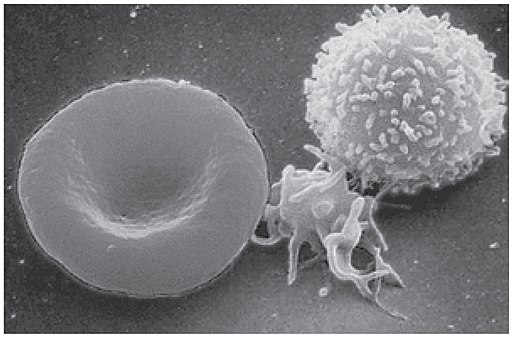Blood, Anemia, Leukemia, and Blood Tests
Blood, Anemia, Leukemia & Blood Tests Chapter Overview
William Wang and Jennifer Kong
Chapter Learning Objectives
By the end of this chapter, you will be able to:
- Identify the primary functions of blood in transportation, defense, and maintenance of homeostasis
- Name the fluid and cellular components of blood and identify their relative proportions in a blood sample
- Identify the composition of blood plasma, including its most important solutes and plasma proteins
- Describe how anemia can develop, its classification, appearance in peripheral blood smears, and treatment
- Briefly explain how leukemia can develop, its classification, appearance in peripheral blood smears and bone marrow biopsies, and treatment
- Compare and contrast the signs and symptoms of anemia and leukemia
- List the specialties of medical laboratory sciences and the tests they do with blood
- Explain the blood test iron studies and how it is related to the diagnosis of anemia
- Briefly describe the journey a blood sample takes in LifeLabs, when being analyzed for hematology and blood chemistry tests

Blood is essential for life: it delivers all the oxygen and nutrients the tissues need and removes their wastes. The cellular components of blood—referred to as the formed elements—include red blood cells (RBCs), white blood cells (WBCs), and cell fragments called platelets. Plasma, which is mostly water, suspends the formed elements and carries within it everything that is water soluble (e.g., nutrients and electrolytes). Together, the plasma and formed elements circulate throughout the body as part of the cardiovascular system.
Blood disorders are often associated with disorders of the formed elements. Anemia is a blood disorder involving the abnormal synthesis of RBCs and/or hemoglobin. Anemia is quite common in the population due to a variety of causes.
In contrast, blood cancers – called leukemias – involve an inability to produce mature blood cells from the bone marrow. Leukemias involve the overproduction of abnormal, immature blood cells – called blasts – which crowd out and replace the growth an maturation of blood cells. Leukemias can be subclassified based on the blood stem cell that is abnormally proliferating (lymphoid vs myeloid stem cell) and whether the leukemia develops suddenly (i.e. acute) or long term (i.e. chronic)
From a health care perspective, blood tests are a common part of investigations. However, ‘blood tests’ are actually subdivided (like blood itself) into tests for either the number/quality of mature blood cells (e.g. hematology test will look at the number of RBC, WBC, and platelets) or tests for the content within plasma (E.g. chemistry test will look at amount of glucose and electrolytes within the plasma part of blood). Taken together, these test results can give signs of organ dysfunction, along with a snapshot of a person’s ability to carry oxygen, nutrients, electrolytes.
This chapter is subdivided into:
- Pre-test
- Normal blood production and function (including histology of normal bone marrow & peripheral blood)
- Classification of anemia and leukemia
- Pathophysiology and hematopathology of anemia and acute leukemia
- Interviews with health care professionals diagnosing/treating those with leukemia and discussions its complications
-
- Hematopathologist
- Medical laboratory science technologists (hematology & clinical chemistry)
-
- Videotour of LifeLabs facility: the largest processor of blood tests in Western Canada.
- Post-test
The following abbreviations are used throughout the chapter.
ALL = acute lymphoblastic leukemia
Fe = iron
Hb = hemoglobin
Hct = hematocrit
LIS = laboratory Info system
MCH = mean cell hemoglobin
MCHC = mean cell hemoglobin concentration
MCV = mean cell volume
MLA = medical lab assistant
MLT = medical lab technologist
O2 = oxygen
PCR = polymerase chain reaction
ROI = region of interest
RBC = red blood cell
TIBC = total iron binding capacity
WBC = white blood cell
Media Attributions
- 512px-1900_Blood_cells © Open Stax College is licensed under a CC BY (Attribution) license

